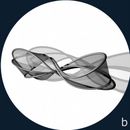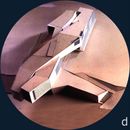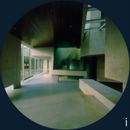








In 1993, a young couple commissioned the Dutch architect Ben van Berkel to design "a house that would be acknowledged as a reference for the renovation of the architectural language". It took the architect six years to fulfil his clients' wishes, creating a house based on the studies of a 19th-century German mathematician.
Curiously, the spatial concept of the new Mercedes-Benz Museum in Stuttgart - a radiant work by Ben van Berkel - demonstrates how the architect has drawn on and experimented with his memory of the Möbius House.
A new architectonic language
In addition to their wish for a new architectural language, the clients looked for an intense relationship with the landscape, as their two distinctive professions allowed them to work from home and therefore to spend more time with their children. The chosen site was amongst meadows and tall beech trees in Het Gooi, a residential area near Amsterdam.
Ben van Berkel understood that the new architectural language he was asked for should be a direct consequence of their new way of life. The idea of two people moving along their own routes, but sharing certain moments - possibly also reversing roles at certain points - was elaborated into the built object. The house had to knit together the different activities which each member of the family was involved in at different times into one structure: work, sleep, socialise and family life, as well as the need to be alone. Thus the notions of time and duration were important concepts right from the beginning, and ones which would later influence how the house and its objects would be perceived from different viewpoints.
Diagram of 24 hours of living
The scheme to convey these features was found in the Möbius band, a diagram studied by the astrologist and mathematician, August Ferdinand Möbius (1790-1868). By taking a rectangular strip of paper and marking its corners, A -superior- and B -inferior- in one side, and C -superior- and D -inferior- on the other, the Möbius band is constructed by twisting and joining corners A with D, and B with C. The result is a strip of twisted paper, joined to form a loop which produces a one-sided surface in a continuous curve. It is a figure-of-eight without left or right, beginning or end.
By giving the Möbius band a spatial quality, the architect has designed a house that integrates the programme seamlessly, both in terms of circulation and structure. Movement through this concrete loop traces the pattern of one's day activities. Arranged over in three levels, the loop includes two studies (one on either side of the house for the respective professions), three bedrooms, a meeting room and kitchen, storage and living room and a greenhouse on the top, all intertwined during a complex voyage in time.
With its low and elongated outlines, the house provides a link between the different features of its surroundings. By stretching the building's form in an extreme way and through an extensive use of glass walls, the house is able to incorporate aspects of the landscape. From inside the house, it is as if the inhabitant is taking a walk in the countryside.
The perception of movement is reinforced by the changing positions of the two main materials used for the house, glass and concrete, which overlap each other and switch places. As the loop turns inside out, the exterior concrete shell becomes interior furniture - such as tables and stairs - and the glass facades turn into inside partition walls.
The contortions and twists in the house go beyond the mathematical diagram. They refer to a movement that has moulded a new way of life as a consequence of using electronic devices at work. Ben van Berkel has managed to give an additional meaning to the diagram of the Möbius band, where its new symbolic value - characterised by the blurred limits between working and living - corresponds to the clients' way of life.
The house as an architectonic reference
The concept that generated the Möbius House did not expire with being built. Instead, it became further developed in the architect's mind and now, in the new Mercedes-Benz Museum in Stuttgart, illustrates the history of cars.
With the aim of creating a museum that could be read as an urban space where the car is the protagonist, van Berkel drew three loops in section that were entwined in plan, just as if they were leaves on a tree. In doing so, he managed to achieve variations between the different levels, to challenge both the symmetry and the flatness of the floors, and to create a wide range of paths and shortcuts, such as those found in cities. The leaves of the tree are turned around a triangular void, producing six platforms which make up spaces of varying heights and creating a dynamic exhibition space.
Although the museum is on a much bigger scale than Möbius House, its spatial effect reminds one of the house. For the house, the Möbius strip suggested a plan that interlaced the different movements and activities of the family. For the museum, the trefoil offers a movement between forms of continuity and cross references, between open and closed spaces, which interweaves the different exhibitions organised by the museum. The visitor finds himself immersed in a continuous movement of shifting orientations and crossed viewpoints generated by the different notions of time that the museum recreates.
Captions for illustrations
a. Ben van Berkel (b. 1957), the founding architect of UN Studio, with Caroline Bos.
b. A representation of the Möbius band.
c. Diagram of 24 hours of living.
d. Working model. View from southwest.
e+f. Ground floor and first floor: 1. bedroom, 2. office, 3. entrance, 4. bathroom, 5. toilet, 6. ramp, 7. garage, 8. storage room, 9. meeting room, 10. kitchen, 11. porch, 12. living room, 13. chimney, 14. void.
g+h. As the loop turns inside out, the exterior concrete shell becomes interior furniture - such as tables and stairs - and the glass facades turn into inside partition walls. (Photographer: Christian Richters)
i. From inside the house, it is as if the inhabitant is taking a walk in the countryside. (Photographer: Christian Richters)






























